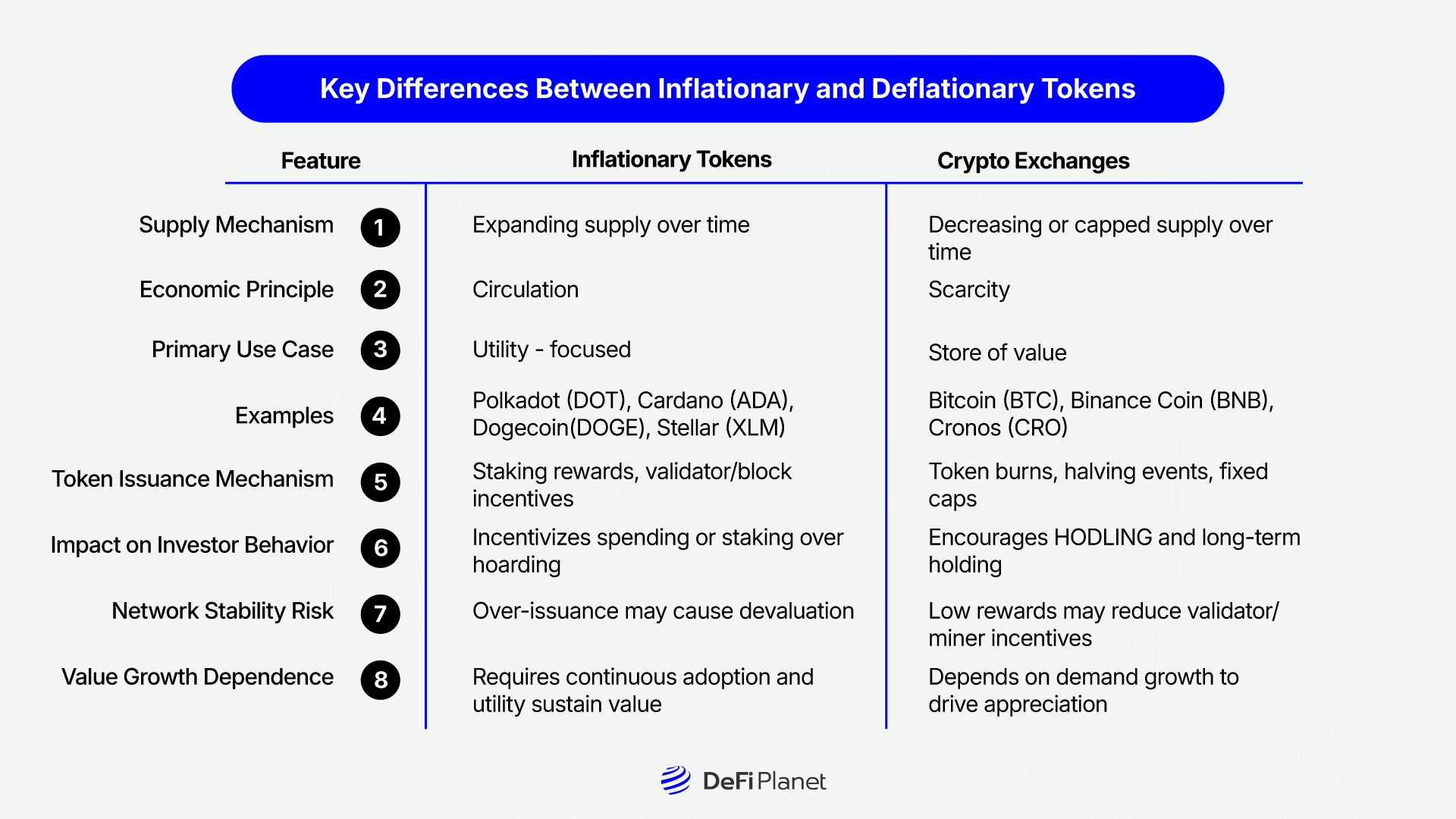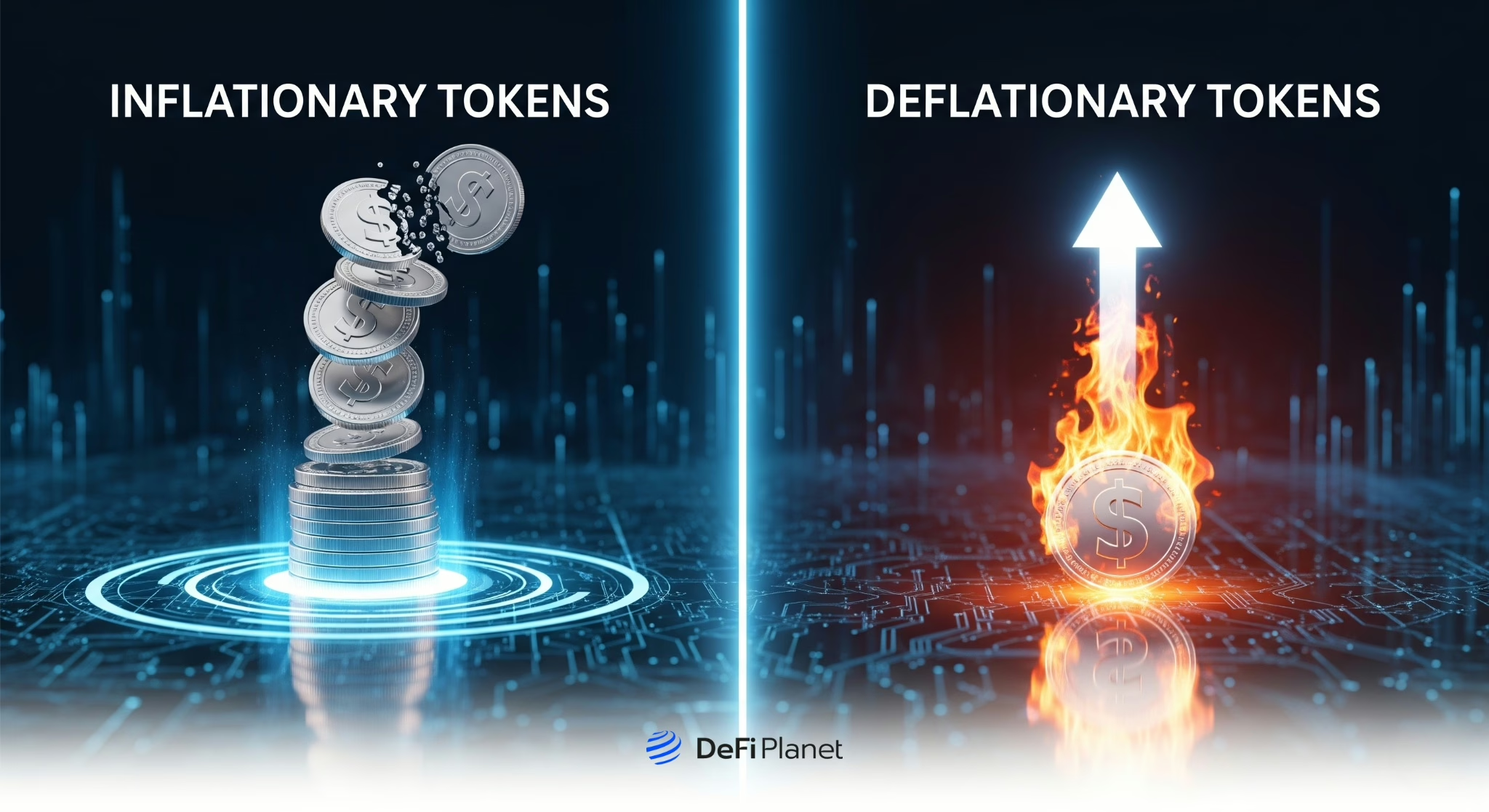On the coronary heart of each crypto asset lies its tokenomics—the financial mannequin defining how tokens are created, distributed, and circulated. Two main paradigms dominate token provide fashions: inflationary and deflationary. These fashions form investor behaviour, decide long-term sustainability, and affect how ecosystems change with time. However what’s the distinction between inflationary and deflationary token fashions, and which holds the important thing to enduring worth creation? On this article, we discover their definitions, financial theories, impacts on consumer behaviour, and long-term implications to uncover which mannequin really drives sustainable worth.
What Are Inflationary Tokens?
Inflationary tokens are cryptocurrencies designed with an increasing provide, which means that new tokens are constantly launched into circulation over time. This improve in token provide is usually constructed into the protocol’s design. It’s typically used as a strategy to incentivize community members and keep the well being and performance of the blockchain ecosystem.
Inflationary tokens embrace ongoing issuance to assist quite a lot of community operations. Frequent mechanisms for inflation embrace staking rewards, validator incentives, and block rewards. For instance, Polkadot (DOT) and Cardano (ADA) reward customers who stake their tokens or take part in community validation with newly minted cash. This serves to safe the community, encourage participation, and hold the blockchain decentralized and lively.
Stellar (XLM) and Dogecoin (DOGE) additionally observe inflationary fashions, although in numerous methods. Stellar beforehand issued a set annual inflation fee of 1%, whereas Dogecoin has no most provide cap, constantly releasing new cash to miners as rewards. These fashions make sure that the networks stay practical and incentivized. Nonetheless, in addition they introduce the problem of sustaining token worth over time, as a rising provide can result in dilution if not matched by demand.
What Are Deflationary Tokens?
Deflationary tokens are cryptocurrencies designed with mechanisms that cut back or strictly restrict the entire provide over time. In contrast to inflationary tokens, which regularly introduce new cash into circulation, deflationary tokens are structured to both lower the present provide or impose a most cap that can’t be exceeded. This scarcity-driven mannequin is commonly used to advertise long-term worth appreciation and fight the consequences of inflation.
There are a number of methods deflationary mechanisms are carried out. Probably the most well-known is the exhausting provide cap, as seen with Bitcoin (BTC), which has a set most provide of 21 million cash. This ensures that not more than 21 million bitcoins will ever exist, making a digital shortage much like valuable metals like gold. Moreover, Bitcoin undergoes scheduled “halving“ occasions roughly each 4 years, the place the reward for mining new blocks is lower in half. So, is Bitcoin inflationary or deflationary? Sure, Bitcoin is deflationary, on account of its capped provide and slowing emission fee.
One other frequent deflationary technique is token burning, the place a portion of tokens is completely faraway from circulation. Binance Coin (BNB), for instance, conducts common coin burns utilizing a portion of the change’s earnings to purchase again and destroy BNB tokens, thereby decreasing the entire provide over time. This mechanism is aimed toward growing the token’s worth by limiting availability as demand grows.
Cronos (CRO), the native token of the Cronos chain, additionally incorporates burning and provide management measures as a part of its deflationary mannequin, additional strengthening tokenomics and investor attraction.
Inflationary vs. Deflationary Tokens: Key Variations
 Understanding the distinction between inflationary and deflationary token fashions is important for navigating the crypto house intelligently.
Understanding the distinction between inflationary and deflationary token fashions is important for navigating the crypto house intelligently.
Shortage vs. Circulation: Financial Theories at Play
The talk over inflationary vs. deflationary tokens is rooted in classical economics ideas, significantly these regarding shortage, provide, and worth creation. These competing philosophies form the best way totally different cryptocurrencies operate and affect their perceived worth, usability, and long-term viability.
Circulation Precept (Inflationary Tokens):
Inflationary tokens align extra intently with the circulation precept in economics, which emphasizes the significance of liquidity, accessibility, and utility in a rising economic system. By constantly introducing new tokens into circulation—whether or not by staking rewards, validator incentives, or different issuance fashions—these cryptocurrencies encourage extra frequent transactions and foster lively ecosystem participation. This mannequin mirrors conventional fiat currencies, the place managed inflation helps financial development by incentivizing spending and funding somewhat than hoarding. Inflationary tokens are designed to assist scalability, infrastructure improvement, and a variety of use circumstances inside their networks, making them engaging for purposes that require ongoing exercise and participation.
Shortage Precept (Deflationary Tokens):
Then again, the deflationary mannequin attracts from the shortage precept, which asserts that restricted provide mixed with rising demand usually drives costs upward. This is identical logic that underpins the worth of valuable commodities like gold. When a useful resource is uncommon and troublesome to acquire—however in excessive demand—it tends to be seen as a retailer of worth.
Deflationary tokens resembling Bitcoin (BTC), with a capped provide of 21 million, are also known as “digital gold” because of this. Their design limits the speed at which new tokens could be created, and in some circumstances, actively reduces the circulating provide by mechanisms like burning or halving. This scarcity-based method appeals to those that prioritize asset preservation, long-term worth, and safety towards inflation.
Impacts on Investor Behaviour and HODLing
Inflationary Tokens: Designed for every day utilization and lively circulation, they have a tendency to discourage long-term holding. Buyers are incentivized to spend or stake them to offset dilution. This helps community participation and decentralization, however can result in short-term hypothesis.
Deflationary Tokens: Shortage drives long-term holding behaviour (HODLing). Buyers understand them as hedges towards inflation and store-of-value property. Nevertheless, extreme HODLing can cut back transaction quantity and community utility.
In each circumstances, understanding the traits of an inflationary token or a deflationary token helps traders align their technique with the token’s behaviour mannequin.
Key Perception: The psychological facet of token holding typically ties to perceived future shortage (deflationary) versus rapid utility and yield (inflationary).
RELATED: Bitcoin HODLing Technique in 2025: Is Holding Nonetheless the Smartest Transfer?
Protocol Design and Ecosystem Stability
Inflationary Mannequin Design:
The inflationary mannequin in blockchain design entails the dynamic issuance of latest tokens to assist community development and reward validators or stakers. This steady creation of tokens helps fund ongoing improvement and ensures that members are incentivized to stay lively, which in flip sustains community operations. Nevertheless, this mannequin comes with a big threat: if too many tokens are issued, it might result in inflationary strain that devalues the token. Such over-issuance could erode long-term investor confidence and hurt the perceived reliability of the venture.
Deflationary Mannequin Design:
The deflationary mannequin in blockchain design emphasizes shortage as a key driver of worth. By setting a set provide cap, the entire variety of tokens that may ever exist is restricted, which might improve demand and enhance worth over time. This shortage is additional strengthened by burning mechanisms that completely take away tokens from circulation, progressively decreasing provide.
Moreover, deflationary fashions typically incorporate diminished block rewards, resembling Bitcoin’s halving occasions, which sluggish the speed of latest token issuance. This helps lengthen the community’s longevity by preserving shortage. Nevertheless, this mannequin carries a notable threat: as rewards lower, there could also be much less funding out there for ongoing improvement, and validators or miners is perhaps discouraged from taking part. If incentives drop too low, it might result in underfunding and validator exit, in the end jeopardizing the community’s safety and long-term sustainability.
Hybrid Fashions:
Hybrid crypto fashions mix inflationary and deflationary mechanisms to strike a stability between community development, safety, and long-term worth. They situation new tokens to reward validators whereas burning a portion of transaction charges to regulate provide. For instance, Cosmos burns a part of its transaction charges alongside inflationary staking rewards. This adaptive method helps maintain participation, stop oversupply, and keep value stability in altering market circumstances.
Utility vs. Retailer of Worth
When contemplating utility versus retailer of worth, the alignment of a token’s use case performs an important position in its design. Inflationary tokens are usually more practical for lively use circumstances resembling governance, staking, decentralized purposes (dApps), and on a regular basis transactions, the place a gradual or rising provide helps ongoing community exercise.
For instance, gaming platforms typically undertake inflationary fashions to offer steady in-game rewards and foster consumer engagement. Then again, deflationary tokens are typically higher suited as a retailer of worth, specializing in wealth preservation and inspiring long-term holding. Their shortage appeals to traders seeking to safeguard property over time. In the meantime, monetary protocols would possibly implement deflationary fashions to draw and retain long-term capital by emphasizing token shortage and worth preservation. Profitable initiatives fastidiously align their tokenomics with their supposed utility, guaranteeing that token design successfully helps the ecosystem’s targets and consumer wants.
Conclusion: Which Drives Lengthy-Time period Worth?
In the case of deciding which token mannequin, inflationary or deflationary, really drives long-term worth, there’s no easy, one-size-fits-all reply. The influence of every relies upon closely on the token’s core objective, whether or not it goals to function a retailer of worth or energy, an on a regular basis utility, in addition to the energy of its ecosystem’s incentives and governance buildings. Equally vital is the long-term sustainability of the financial design behind the token.
Deflationary tokens have a tendency to draw long-term holders and institutional traders who see them as a dependable hedge towards inflation, banking on shortage to protect wealth. Inflationary tokens, in the meantime, gas lively community participation and foster ongoing improvement by rewarding customers, validators, and builders alike.
In actuality, probably the most profitable initiatives typically discover a stability—mixing components of each inflationary and deflationary mechanics and tweaking provide insurance policies to satisfy the evolving wants of their ecosystems. In the end, the true driver of lasting worth isn’t merely whether or not a token is scarce or considerable. As an alternative, it lies in its means to constantly ship significant utility, uphold sturdy governance, and maintain resilient demand over time. This dynamic interaction is what really builds enduring worth within the crypto house.
Disclaimer: This text is meant solely for informational functions and shouldn’t be thought-about buying and selling or funding recommendation. Nothing herein must be construed as monetary, authorized, or tax recommendation. Buying and selling or investing in cryptocurrencies carries a substantial threat of monetary loss. All the time conduct due diligence.
If you wish to learn extra market analyses like this one, go to DeFi Planet and observe us on Twitter, LinkedIn, Fb, Instagram, and CoinMarketCap Group.
Take management of your crypto portfolio with MARKETS PRO, DeFi Planet’s suite of analytics instruments.”
The publish Inflationary vs. Deflationary Tokens: Which Drives Lengthy-Time period Worth Creation? appeared first on DeFi Planet.


